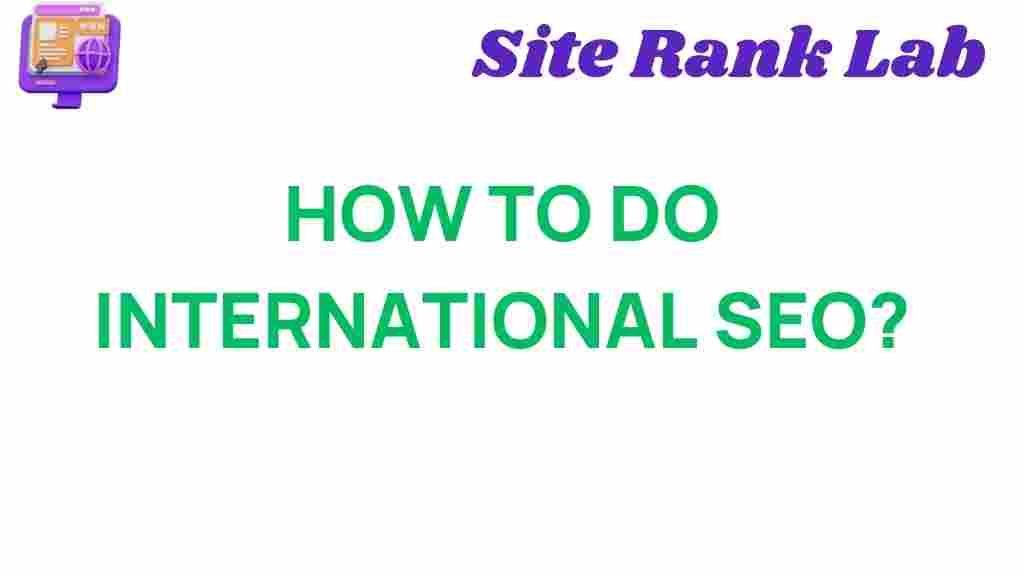What Is International SEO?
International SEO is the process of optimizing your website to target audiences in multiple countries or languages. It involves tailoring your content and technical setup to meet the needs of a global audience, ensuring your website appears in search results that matter most to your business.
With the internet breaking down geographical barriers, businesses aiming to grow globally must master international SEO to unlock their full potential. But how do you start? Let’s dive in!
Why International SEO Matters
Expanding your business beyond local markets allows you to tap into a broader customer base. However, without proper international SEO strategies, your efforts might not yield results. Here’s why it’s crucial:
- Targeted Traffic: Attract users searching for your products or services in their local language.
- Improved Conversion Rates: Provide content tailored to cultural preferences and local needs.
- Stronger Brand Authority: A globally visible website builds trust and credibility.
Key Steps to Master International SEO
1. Identify Your Target Markets
Start by determining which countries or regions you want to target. Use tools like Google Analytics to analyze your existing traffic and identify where your potential customers are located. This data helps prioritize efforts for the most promising markets.
2. Choose the Right Domain Structure
Your domain structure plays a vital role in signaling to search engines which audience your website targets. Common options include:
- Country Code Top-Level Domains (ccTLDs): Example: yourwebsite.fr for France.
- Subdirectories: Example: yourwebsite.com/fr.
- Subdomains: Example: fr.yourwebsite.com.
Each structure has its pros and cons, so evaluate them based on your resources and objectives. For example, ccTLDs offer clear targeting but may require separate SEO efforts for each domain.
3. Use Hreflang Tags
Hreflang tags are essential for international SEO as they help search engines understand which version of your page to show to users based on their language and location.
For instance:
<link rel="alternate" hreflang="en-us" href="https://www.yourwebsite.com/us/"> <link rel="alternate" hreflang="fr-fr" href="https://www.yourwebsite.com/fr/">
Implement these tags correctly to avoid content duplication and provide the best experience for your audience.
4. Optimize Content for Local Audiences
Localization goes beyond translation. Adapt your content to resonate with the culture, preferences, and search behaviors of your target audience. Key considerations include:
- Language: Use native speakers for translations to ensure accuracy and relatability.
- Keywords: Conduct local keyword research to understand how users search in each region.
- Currency and Measurements: Display prices, dates, and units in familiar formats.
5. Leverage International Link Building
Backlinks from reputable local websites boost your website’s authority in specific markets. Build relationships with regional influencers, bloggers, and industry leaders to create a robust link profile.
6. Monitor Performance
Regularly evaluate the effectiveness of your international SEO efforts. Tools like Google Search Console and SEMrush can help you monitor keyword rankings, traffic, and user behavior by country.
Troubleshooting Common Challenges in International SEO
Implementing international SEO isn’t without hurdles. Here’s how to address common challenges:
- Duplicate Content: Use hreflang tags and canonical tags to avoid being penalized for similar content across different regions.
- Slow Page Load Times: Optimize images, use Content Delivery Networks (CDNs), and ensure fast server response times.
- Incorrect Geotargeting: Double-check your domain setup and ensure the right language and region settings are applied in Google Search Console.
Conclusion
International SEO is a powerful tool for businesses looking to expand their online presence globally. By following the strategies outlined in this guide, you can optimize your website for multiple markets and connect with a wider audience.
Remember, international SEO is an ongoing process that requires continuous refinement. Stay informed about changing trends and algorithms to maintain your competitive edge.
Need help with your SEO efforts? Check out our comprehensive SEO services to boost your online visibility.
This article is in the category SEO and created by SiteRankLab Team
